Broadband at a County Crossroads… Again
by Robert Lynch, September 26, 2021
“Tompkins County can’t become everybody’s ISP.”
With those memorable words, Tompkins County Legislator Martha Robertson planted her flag September 16th at yet another of those intermunicipal come-together bull sessions where town leaders and county lawmakers trade ideas—and frustrations—about the lack of adequate and affordable broadband Internet in our county.

Most recently, the discussion found its home September 23rd at a committee of the County Legislature Robertson chairs, one where a reading of the room brought a sense that any thought of a governmentally-run, countywide network to compete with the likes of Haefele and Spectrum is just about dead.
“I know you don’t want to take anything off of the table,” cautioned Lansing legislator Mike Sigler. “But I just don’t see municipal broadband. I don’t see us starting a company.”
Why not take the plunge to set up a public-option ISP alternative? It’s done some places with municipal power. Sigler distinguished the two. “It works if you own the power company,” he said. “You’ve already got the trucks; you’ve got the customer service… but to start from scratch, it would require such an overbuild… to what’s already existing. It seems that’s not a great direction for the County to go in.”
Actually, the Town of Dryden is trying just what Sigler is rejecting. It’s attempting to string its own lines to compete with the private companies. And Dryden Supervisor Jason Leifer has become municipal broadband’s leading local cheerleader.
“It’s not just people who don’t have a service,” said Leifer at an August meeting of the Tompkins County Council of Governments (TCCOG). “It’s people who have no competition, who are relying on DSL, or who are relying on satellite, or rely on Spectrum, which to be frank, is way too much money for way too little, and it’s unreliable.” (See story posted on this website August 27th.)
But public broadband would cost money—big bucks; the kind of big bucks that would likely increase taxes. And legislators find the tradeoff daunting especially should they lean on data—admittedly flawed data—that suggest that only a small fraction of local residents, most living in the county’s southern reaches, lack access to any high-speed Internet at all.
A September 23rd meeting of Robertson’s Housing and Economic Development (HED) Committee provided the County Planning Department’s point person on broadband, Nick Helmholdt, his first opportunity to detail current courses of action following his boss’s decision to pause a $60,000 consultants’ study August 6th. Planning and Sustainability Commissioner Katie Borgella then called a halt to the work after only the first of the study’s four phases. She concluded any broadband solutions that consultants might devise would serve too few households to justify taxpayer investment.
The consultants commenced work in April, when “middle-mile” cable stringer Southern Tier Network (STN), a regional nonprofit, partnering with Fujitsu Corporation, launched a four-part study that some County and municipal leaders had hoped would lead to government-run broadband. But the study faltered when its first-stage Market Assessment revealed that an STN system might reach only 269—or maybe 473—unserved homes. Borgella paused the study before consultants ever got to part two… or to calculating cost.

Helmholdt’s report—and County legislators’ reaction to it—underscored the common speculation of recent weeks that continuing the STN/Fujitsu study to its conclusion has become a lost cause. Instead, as many municipal leaders (including this writer) have publicly recommended, the County may tap unspent moneys from the Fujitsu study to underwrite a county-wide survey of hard-wired Internet’s true reach, granular down to the last road, if not the last house.
Helmholdt advanced such a physical survey of fixed broadband as one of three alternative “paths forward” in working toward universal coverage. Under this path, the Planning Department would end the STN/Fujitsu study and instead use the survey to prod private providers to extend their cables to reach neighborhoods not now served.
Already, this strategy claims one success to its credit. After the Town of Newfield commissioned a road-by-road survey of its own, the County, Town, and Point Broadband collaborated to extend fixed service to some 180 homes in the “Millard Hill Corridor,” a deal the County Legislature finalized September 14th. (See Sept. 15th story; posted earlier.)
While physical surveys provide “really detailed street-level information,” Helmholdt told the committee, any report a surveyor hands up “doesn’t have a great shelf life.” So while the data may pinpoint pockets of need, deals must be struck promptly with a chosen provider before a competitor swoops down and strings cables to those places first.
Helmholdt’s remaining “paths forward” for lawmakers included potential resumption of the STN/Fujitsu study and, alternately, evaluating the feasibility of a Municipal Broadband System.
With its limited spread of service, the STN solution—namely using STN middle-mile fiber to connect particularized dead-spots—“will be pretty expensive,” Helmholdt forecast. “And it could be challenging to finance with the existing Federal sources,” considering, he said, how few homes the system would serve.
Moreover—and not well publicized in prior discussions—the planner cautioned that the STN/Fujitsu prescription would only benefit three of Tompkins County’s nine rural towns; namely Newfield, Danby and Caroline. While residents in those three would gain service, other “very small pockets of homes” in other parts of the county would not be “captured” by the service constructed, the planner cautioned.
Helmholdt’s final path forward would lead to the municipal system Dryden’s Leifer would welcome, but most on the Legislature’s committee decidedly resist.
To its credit, said the planner, municipal broadband would carry the advantage of providing universal service and addressing concerns about quality and competition. It would be “a whole new potential service the County would be operating,” Helmholdt said. It “could also potentially address every unserved household in the County.”
But the drawbacks loom large. A municipal service “would require a substantial amount of time to both evaluate and establish, Helmholdt said, adding that just investigating the option could prove exhaustive. “A study of this magnitude would be pretty thick,” he cautioned.
Then there’d be the “public responsibility for the ongoing cost of maintenance and operation.” Moreover, government would find itself treading on private turf. A public system would “overbuild” and therefore compete against existing commercial providers. In effect, its cables would go virtually everywhere.
****
“I’m ready to give a direction,” Lansing’s Sigler piped up. “I know there are people that aren’t covered. But frankly, we do have pretty decent coverage. We’re over 90 per cent broadband in this county.” (Sigler may have relied on the admittedly flawed FCC coverage data that almost everyone agrees exaggerates broadband’s true reach.) “So it seems we’re really trying to reach these pockets, these people who don’t have it,” Sigler said, framing the discussion.
“I like the idea of reducing the cost to people,” Ulysses/Enfield legislator Anne Koreman said, extending a passing compliment to the municipal option. But municipal broadband, she conceded, “seems like a huge undertaking;” an endeavor “I’m not inclined to want to do.”

The one attending legislator whose constituencies have the most to gain was Dan Klein, drawn from cable-deprived Caroline and Danby. Klein raised the idea of “dragging out” STN and Fujitsu; extending the study’s “pause,” yet reserving the possibility of resuming it should private ISP’s not embrace a willingness to serve. “I think it would be premature to end the Fujitsu study before we’ve gotten as far as we can with that ‘other exploration,’” Klein said, his referenced exploration being the physical survey and subsequent private inquiries.
Planning Commissioner Borgella cautioned that the County can only wait so long. Her Department had told consultants a decision on continuation would be made in August. It wasn’t. Fujitsu’s been patient. But the County had negotiated a bargain price at the start. And further delay might require a new contract at higher cost, she said.
Of those at the committee’s meeting table, virtual or otherwise, only Klein held out much hope for municipal broadband’s potential conception. But even he was skeptical. Klein urged the committee look toward Dryden’s years-long municipal broadband effort as a guide. “I’m a little doubtful,” Klein said of Dryden’s prospects. “If they can pull it off,” he said, “there’s a model for us. If they can’t pull it off, there’s some information for us, too.” Municipal broadband, Klein opined, is “an ideal thing to happen.” But he, like other legislators and planning staff, admitted its creation would take “a lot of study and a lot of time.”
Should the earlier-ballyhooed STN/Fujitsu study now meet its unceremonious demise, Tompkins County will owe the consultants about $24,000 for time already spent. The unused portion could bankroll the increasingly likely physical survey, which Helmholdt pegs at between $15,000 and $25,000. Once the survey’s completed, the County would likely continue its piecemeal approach, bargaining with private firms, using the Newfield-Point Broadband agreement as an example.
Enfield, Newfield and other municipalities had pledged funds—most of them $5,000 apiece—to defray the STN/Fujitsu study’s expense. The HED Committee Thursday recommended the Legislature release municipalities from those prior commitments and tap money from the County’s Fund Balance instead.
“I’m just glad what we’re doing in Dryden is moving forward,” Supervisor Leifer said of his Town-attempted municipal venture to TCCOG in August. As for partnering with private providers, he said, “if you just let them fill in the blanks, you don’t even address the competition problem.”
Danby Supervisor Joel Gagnon agreed with Leifer. Piecemeal extensions, Gagnon told TCCOG, only “become part of the private network and part of the monopoly supply.”
“It does get it to where it needs to go,” Gagnon admitted of private agreements, “but our history of doing that has not been particularly satisfactory. We’re not taking a serious look of the cost effectiveness in the long run of a public network.”
But politicians often have limited eyesight and short attention spans. They cast their gaze on what matters most—the next Resolution, the next budget, the next election.
And though she’s relinquishing her seat to a newcomer in January, Robertson, a reliable legislative liberal, still counseled her colleagues to remain frugal and to see public-option broadband as simply a reach too far.
“I don’t think [it] is something we can take on,” Robertson warned.
###
Newfield Board OK’s Solar Law; sets cannabis opt-out hearing
by Robert Lynch, September 23, 2021

Statutes don’t often win beauty compliments. Newfield’s new Solar Law did.
“It’s well thought-out, easy to understand, and it’s pretty,” Councilperson Joanne James remarked during a quick and largely uneventful Public Hearing Thursday (Sept 23rd) prior to the Newfield Town Board giving its unanimous approval to a thorough overhaul of the Town’s 2017 law regulating solar generating installations, whether large or small.
“The purpose is not to impede or slow down solar development,” Planning Board secretary Jim Haustein stressed, as he walked the Board and public through the Hearing’s 30-slide PowerPoint presentation. It’s to “create a win-win situation.”
Haustein explained solar technology is changing rapidly. New York, he observed, seeks to rely increasingly upon renewables. Newfield is already home to two, new prominent arrays; a 7.5-Megawatt, 30-acre system off Millard Hill Road; and a 4-Megawatt, 26-acre solar farm close by, off Burge Hill Road. Both would be classified as “Large” arrays under the law’s new three-tiered classification system.
Expanding the existing law’s reach, the newly-adopted Newfield controls would also cover “Battery Energy Storage Systems,” a rapidly-growing technology that permits solar energy generated during the day to be used by customers at night.
Haustein, whose Planning Board labored on the new law for months, said the planners wrote it to be consistent with the Town’s Comprehensive Plan, to have it fall in line with laws for neighboring communities, and to update a 4-year old law that only covered larger systems.
Under its provisions, the larger the solar farm—or the battery storage facility—the more extensive the law would regulate. Small-scale systems, such as those on homes, would face minimal oversight. Medium-sized units—which Haustein equated to those atop the McGuire dealerships—would need Site Plan Review and Planning Board approval.
The largest systems, with greater than 25 kilowatts capacity and spread out over at least 2.5 acres, would need not only Planning Board consent, but also a visual impact assessment, species protection compliance, and a developer’s assurance that the farm would provide “tangible community benefits.” It would also demand a “community meeting” to ascertain public sentiment.
Land use controls sometimes trigger backlash. The Newfield Solar Law did not. Only a handful of residents asked questions, a majority of the speakers either local officials or political candidates. They posed questions; not criticism. The hearing and the Board’s subsequent vote took just over 40 minutes.
****
Similarly non-controversial was the Newfield Board’s brief revisit of New York’s new cannabis law, a statute that gives municipalities the option to opt-out of allowing marijuana dispensaries. Although the evening’s agenda listed the prospect of putting the issue on November’s ballot, the deadline for doing so has passed. So instead, the Town Board decided to schedule a Public Hearing on an opt-out law for October 28th, the same night as its Budget Hearing.
As to marijuana sales, “I can’t see it as being a windfall,” remarked Councilperson Joanne James cautiously.
Both Supervisor Michael Allinger and Councilperson Christine Laughlin expressed the strongest reservations about the dispensaries. Both feared storefront pot sales might change the character of the Newfield business district, especially since the Town lacks zoning.
Nevertheless, most Board members appeared open to persuasion. They saw the late-October hearing as a good way to gauge public opinion, especially since the Town Board must avail itself of New York’s one-way opt-out provisions before year’s end.
In yet a final matter, the Newfield Board took its first steps toward securing a multi-million dollar State grant to upgrade its aging water and sewer systems. The Board passed measures to seek assistance toward $4.2 Million in water upgrades and $741 thousand in sewer improvements. If approved, the State would pay 60 per cent of the total cost. Laughlin cautioned that even if the money comes through, the Town could always back out of the projects later.
###
County funds testing prong of Enfield Vaxx Policy
by Robert Lynch, September 22, 2021
Had you not scoured the agenda, you might have missed it.

With all the heavy lifting done in committee the day before, the Tompkins County Legislature Tuesday (Sept. 21st) gave quick and unanimous approval to expansion of a County-funded—and likely federally reimbursed—COVID-19 surveillance testing program that will now cover local municipal employees. The expansion would permit the Town of Enfield’s workforce to obtain free weekly asymptomatic testing at Cayuga Health Systems’ mall-based sampling site should they opt-out of a vaccination mandate policy under consideration by the Enfield Town Board, but not yet adopted.
Buried within Tuesday’s “consent agenda,” a laundry list that contained multiple, routine actions, the testing policy’s expansion cleared the Legislature without discussion.
“I’m glad that the Committee has been receptive to this,” Enfield Councilperson Robert Lynch (this writer) told the Health and Human Services Committee one day prior to the Legislature’s vote. “There are still other issues in Enfield that we have to resolve with regards to the vaccination policy,” he cautioned the Committee. “They’re Enfield issues. I’m not asking you to solve them today. That’s for us to solve. But at least the financial aspect will be rectified by this Resolution.”
Tompkins County began funding free surveillance testing for the general public in September of last year after insurance companies began denying reimbursement for routinely testing those who failed to show COVID-19 symptoms. While the program funds the tests for most residents, it does not include those whose employers demand the samples. In those instances, the employer must pay the charge.
But with some municipalities now considering following County Government’s lead and requiring employees either vaccinate or get regular tests, municipal boards, including Enfield’s, have raised the expense factor as a potential obstacle to a mandate policy’s adoption.
When Councilperson Lynch initially introduced Enfield’s vaccination mandate this August, Supervisor Stephanie Redmond countered that the weekly testing cost for employees who chose not to vaccinate—even if only one or two—could break the Town’s budget. Tuesday’s action by the County Legislature would appear to remove the financial barrier.
Yet even with County funding an increasingly likely prospect, the Enfield Board rejected the vaccinate-or-test policy at its September 8th meeting. Councilperson Lynch, the policy’s lone supporter in the September vote, has pledged to resubmit a modified version of the mandate at the Board’s October meeting.
Following Supervisor Redmond’s raising her cost concerns in August, Lynch contacted several in County Government, including Health Committee Chair Shawna Black in search of a solution. Subsequent committee deliberations led to this week’s two-step legislative endorsement.
Tompkins County initially bankrolled its surveillance testing policy with hundreds of thousands of dollars from its Contingency Fund. But more recently, a federal agency (FEMA) has agreed to cover the cost fully. Deputy County Administrator Amie Hendrix informed both the Health Committee Monday, and then the full Legislature on Tuesday that FEMA reimbursement should also cover municipal employee tests.
As for the municipal collection and testing procedures, Hendrix cautioned the committee, “The logistics on that are not as simple and straightforward as maybe we had thought originally.”
Beginning next month, County Government, with its large workforce, will send around an employee to collect test samples from various worksite drop boxes and then take them to a hospital lab for analysis. Hendrix indicated the Town of Ithaca may do the same. But for smaller municipalities, like Enfield, employees would likely have to drive themselves to the testing site. There’d be no County pickup.
“We need to work with each municipality to look at how that program would look,” the deputy administrator told the committee.
But some governments, Hendrix advised the Legislature, want to go one step farther. She said the City of Ithaca may choose a more ambitious regimen, namely to surveillance test every employee regularly, whether vaccinated or not—a policy Redmond has also suggested Enfield do. Hendrix doubted Ithaca’s more aggressive strategy would qualify for FEMA’s blanket coverage. As a result, she told the committee the City may need to contract separately with Cayuga Health and seek separate FEMA reimbursement of its “more broadspread program.”
In other County Legislature business Tuesday:
- The Legislature unanimously appointed Tamara Scott as the County’s new Republican Elections Commissioner. Scott, endorsed by the local Republican Committee, has served as Interim Commissioner since the recent retirement of Commissioner Elizabeth Cree. Stephen Dewitt continues as the Democratic Commissioner.
- The Legislature paid tribute with a moment of silence to mark the passing of their former colleague, Peter Stein, who represented the Town of Ithaca. Stein died Friday, September 17th, at age 89. A retired Cornell physics professor, Stein had served on the Legislature from 2010 through 2017. Current legislators and staff took turns sharing their memories of Peter.
- And on a matter likely to enthrall only the most fervent of financial pencil-pushers, the Legislature updated its long-debated Fund Balance Policy, setting new guidelines for how much money the County should put aside in what amounts to its government savings account.
The proposed policy changes hobbled to the legislative floor after having been supported in one committee, but crippled by a split voter in another. The old policy had called for setting aside in the General Fund Balance moneys equal to only ten per cent of the County’s annual budget. (It had been just five per cent a few years back.) What emerged from the single committee that could reach agreement—the Budget and Capital Committee—was a set-aside of between 18 and 23 per cent of an annual budget. The Legislature Tuesday first rejected an amendment that would have chopped the top figure down to 20 per cent; then passed an amendment that eliminated the top figure altogether. The 18 per cent number—only a guideline; not a hard-and-fast constraint—still stands above the percentage financial experts recommend.
Having an upper limit could “guide and color the decisions of staff and the Legislature,” warned Dryden’s Martha Robertson in supporting a lower top limit. Robertson feared the upper number of the two would become the fund balance’s de facto target. We could “lose out on opportunities,” she said. By “opportunities,” she most likely meant added spending.
Her Dryden colleague, Mike Lane, however, supported keeping the higher number high. He even voted against the final Resolution. What an upper range does, said Lane, is alert us of when the balance creeps too high, perhaps signaling a need to cut taxes. Moreover, he said, the higher number underscores the importance that “we have a good amount in the bank for things that may come along.”
###
Slice and Dice
Competing Congressional Maps would bring us different political bedfellows
And one could bring to our District both Katko and Tenney
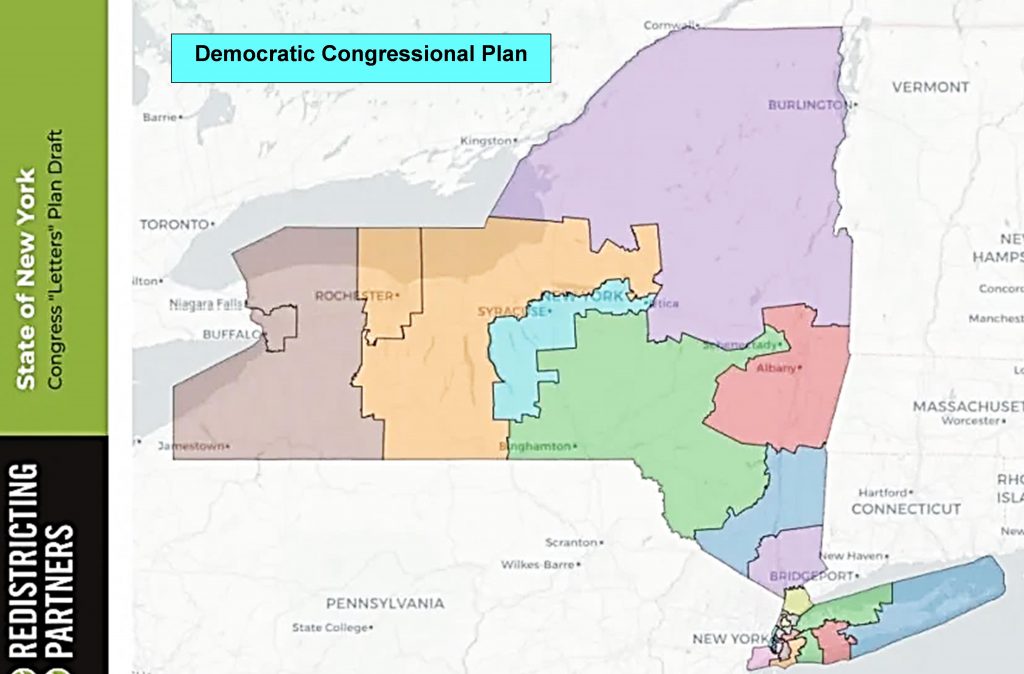
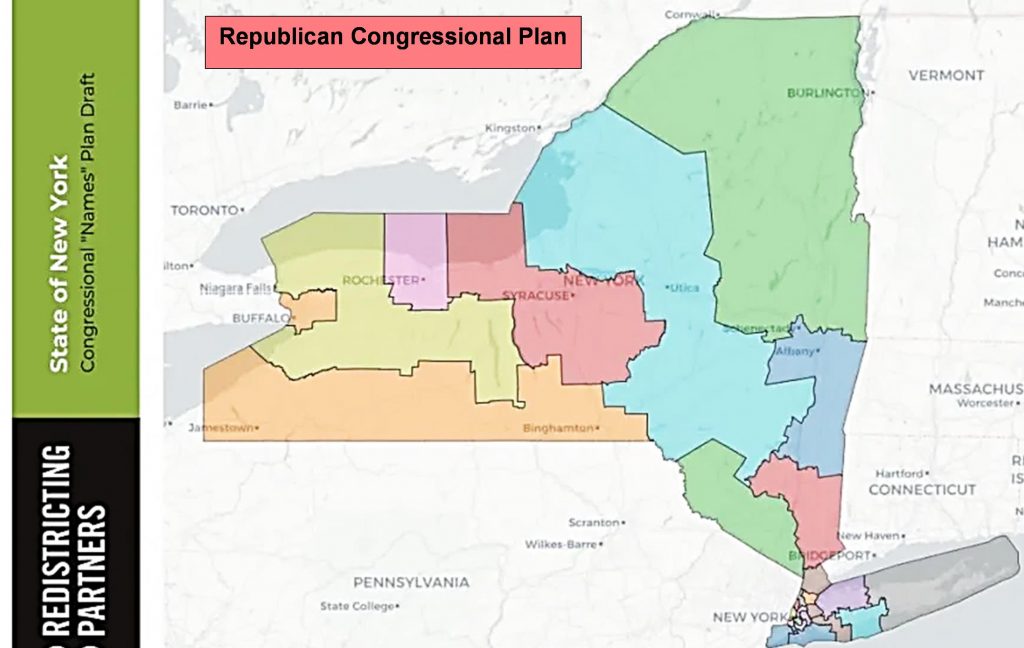
by Robert Lynch, September 16, 2021; Updated September 17, 2021
If Democratic line-scribblers on New York’s party-divided Independent Redistricting Commission prevail, Tompkins County voters will be looking north—not to the south or west—to cement their Congressional loyalties during the next political decade.
Draft maps submitted Wednesday (Sept. 15th) by the Democratic partisans on New York State’s now fractured and visibly wrangling Redistricting Commission, would pull Tompkins County out of the hundreds-mile-long Southern Tier District where retiring Congressman Tom Reed currently holds sway. Instead, Democrats would put Tompkins County as the southern anchor of a slightly more compact district, one that would curl right from Ithaca up Cayuga Lake’s eastern shore, then through Syracuse and on to Utica. Curl right, perhaps; but likely lean politically left.
In fact, the Democrats’ plan—given the upper hand the way both Empire State politics and Commission rules are structured—would actually carve the Reed District into oblivion. The Southern Tier sprawl of counties, most bordering Pennsylvania from about Elmira heading west to Lake Erie, has long been a fixture in regional Congressional politics. Think Stan Lundine and Amo Houghton.
But on the other hand, if Commission Republicans can somehow wrest control, the Reed District would still survive. Indeed, it would expand. And it would remain with most of Tompkins County still within it, including Enfield and Newfield.
Perhaps by political design, the Democrats’ alternative, if adopted, would put two Republican Congressional incumbents, John Katko and Claudia Tenney, in the same District—ours. It would set the stage for a knock-down Republican Primary, its winner to face a Democratic challenger yet to emerge, yet a candidate likely to hold a voter registration edge.
At the same time as Congressional districts would get sliced and diced, the split Commission’s competing maps could spell changes down-ballot as well, namely in races for the State Legislature. Most notably, the Republican map—but not the Democratic one—would chop incumbent Democrat Anna Kelles’ home base of Tompkins County right down the center of Cayuga Lake. The Republican map, based on its grainy approximation, would lob off the Towns of Enfield, Newfield, and Ulysses from the rest of Tompkins County and merge those towns into a district that would include Seneca, Yates and Schuyler Counties, among others.
For the State Senate, the Democratic—and it appears also the Republican—maps would provide local Democrats something they’ve long sought for decades, namely a single district representing all of Tompkins County. But the similarity stops there. The Democratic Senate draft would tie Tompkins County to Binghamton and its western suburbs. The GOP alternative would link Tompkins with several northern Finger Lakes counties in Republican Pam Helming’s District. Helming already represents Lansing.
“What an embarrassment!” an old hand at local government and media texted this writer as we both concluded watching the Redistricting Commission’s brief half-hour Wednesday session, a meeting hyped for an unveiling of proposed maps, but instead consumed by posturing and preening among Commission members, most of them off microphone, muffling through masks.
“I was negatively surprised when I saw the maps,” said member Charles Nesbitt, a former Assembly minority leader and one of the few members whose words could be understood, since he was talking remotely, unmasked. “Communities of interest were entirely ignored,” Republican Nesbitt complained. “I can see nothing but confusion …. I believe that a fair reading of the Constitution does not contemplate this process that we’re about to go forward on. So let’s do better.”
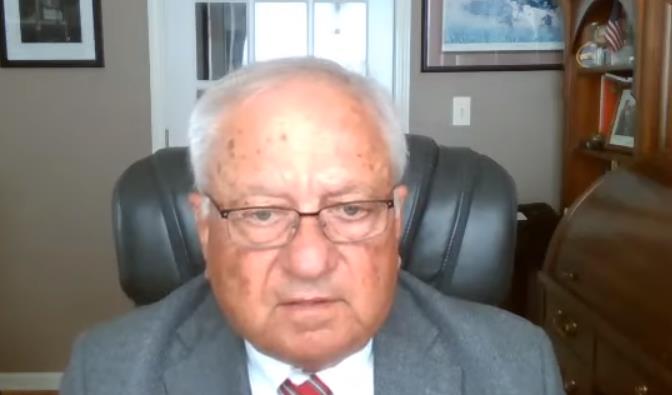
The handing forth of competing, partisan maps surely complicates the Redistricting Commission’s mission. The bipartisan entity, created by a constitutional amendment in 2014, was established supposedly to take partisanship out of line drawing. But the latest deadlock could thrust the process right back into the smoke-filled room, one in which majority Democrats hold the upper hand.
As Nicholas Fandos and Grace Ashford wrote in the New York Times:
“Under the New York Constitution, the redistricting commission leads the way in drawing maps. But if it fails to come to a consensus among itself or delivers lawmakers a map that they don’t like, the Legislature can overpower the body and establish almost any map it chooses, so long as the districts meet constitutional requirements and are roughly equal in size.”
And as the Times reporters observed, “Privately, the Republicans fear that Democratic commissioners have no intention of finding an agreement and would prefer to let the body fail so they can kick the process directly to the Legislature to draw more advantageous maps for their party.”
Local residents will get an opportunity to sound off about the redistricting plans—either in-person or virtually—at a series of Public Hearings, the nearest to be held in Binghamton October 25th and in Syracuse October 26th.
****
One of the more common themes voiced at the Commission’s August 9th Southern Tier Public Hearing was the need to preserve the elongated Southern Tier District, despite the geographic separation of its constituents and the impediments that confront candidates who seek to represent it.
The 23rd District’s breakup would be “detrimental to the region’s recovery,” Bill Mullaney, President of Corning Community College told the Hearing. There’s a “delicate ecosystem of the Southern Tier,” he said. Many commenters agreed. At times one gained the impression community leaders had been recruited to strike a common theme. They repeatedly said that Southern Tier rural counties hold a common “community of interest,” a key criterion in any redistricting.
The Democrats’ plan—but not the Republicans’—would render the Southern Tier District a thing of the past. The Democrats’ draft map would slice central and western New York districts with a series of vertical cuts, in two instances extending districts all the way from Lake Ontario to the Pennsylvania border. Binghamton would be swept into the district of Hudson Valley Democratic Congressman Antonio Delgado. With Reed retiring when his current term expires next year, the Reed seat, for some, seems ripe for the picking. Many of the political battles, some observers say, are to preserve—or endanger—Democratic incumbents, including Delgado, whose constituencies straddle the Hudson River from Albany to the outskirts of New York City.
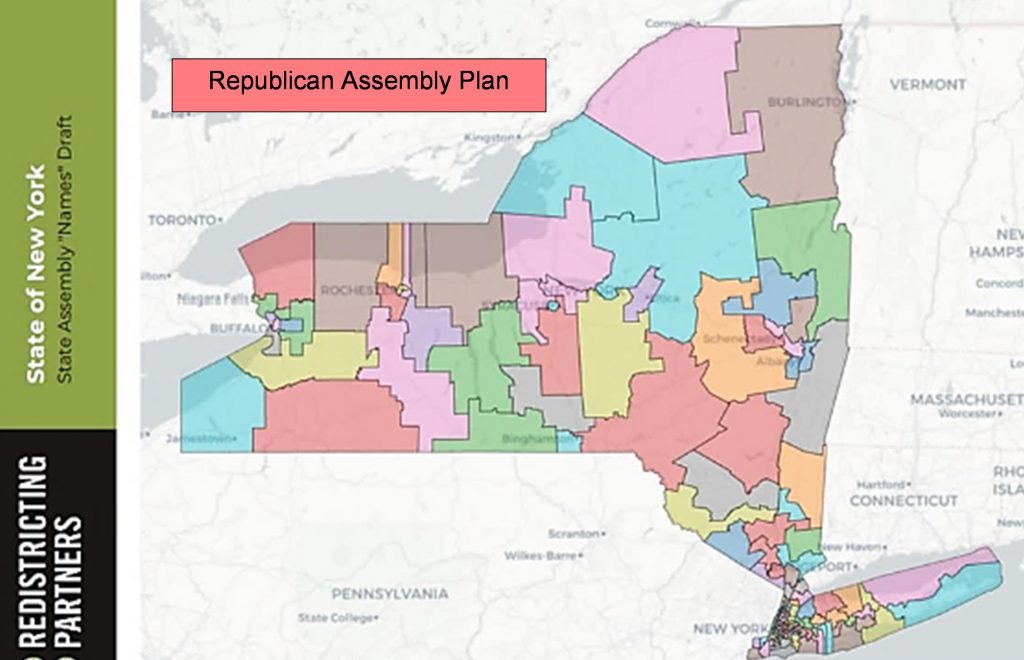
But while the Congressional carving of Reed’s District might be predictable, the unexpected Republican slicing of Kelles’ home county of Tompkins becomes more of a surprise. The Kelles’ seat is seen as safe; well-suited for “packing” Democrats within its borders and leaving outlying rural areas more competitive. The Democratic plan would recognize that fact. The GOP’s submission does not.
Perhaps the Republicans hope to “crack” Kelles’ Tompkins County base; effectively to divide and conquer. Or maybe the division just fell as the byproduct of strategizing elsewhere. In any event, the Republican plan would give Kelles (or her challenger) new constituencies in Tioga and Broome Counties. The Democrats’ alternative, while keeping Tompkins in Kelles’ camp, would extend the Assembly District north along Cayuga Lake’s eastern shoreline and almost touch Syracuse.
###
Legislature earmarks (just) $7 Million for County Post-COVID Relief
by Robert Lynch, September 15, 2021
Let’s first give it a nickname: “Mock-ARPA.” (It sounds better than “Fake-ARPA.”)
Now, let me explain why we’ve named it such.
Months ago, the Federal Government pledged Tompkins County nearly $19.9 Million through the American Rescue Plan (ARPA). In late-July, though not all agreed, the County Legislature assigned all of the expected, multi-year federal assistance to “Government Operations,” a fancy phrase that covers just about everything. And in part to save on paperwork, three-quarters of the total was set aside as “Cash for Capital,” funds to be spent on future building projects and the like. (See story posted here July 20th.)
At the time, lawmakers promised recalcitrant hold-outs they’d revisit post-COVID funding later, strongly indicating they’d tap the County’s own massive surpluses—its Fund Balance—to underwrite the human service needs that critics asserted Uncle Sam’s funds were truly intended to address.
That brings us to Wednesday (Sept. 15), when the County Legislature made good on its July promise—sort of.
Following more than two hours’ of eye-glazing discussion, and with only Danby’s Dan Klein in dissent, the Legislature earmarked $7 Million in local moneys to future grants under the “Tompkins County Recovery Fund.” (That’s why we’ve called it “Mock-ARPA.”)
No one’s yet decided exactly how the money will be doled out… or to whom. No doubt, the County Legislature will have the final say. But it’ll likely be a third-party agency, selected later by the County, that’ll vet the many expected non-profit applicants angling for support.
“The idea of this recovery fund is that it does allow the community to recover,” said legislator Leslie Schill, who predicted the spending, handled properly, could accomplish “significant, transformative change.”
Schill was one of the Legislature’s “Gang of Three,”—another apt nickname—that over recent weeks crafted the Recovery Fund Proposal. They took on the task after lawmakers got hopelessly lost during an unfocused, hours-long, August 10th study session that would have challenged the best of reporters to find a coherent story line.
What Schill, Rich John, and Mike Sigler, that Gang of Three, came up with and unveiled for the first time Wednesday—namely a two-page, bullet-pointed, targeted implementation plan for legislators, administrators and staff—legislative colleagues then promptly took their turns picking apart, and significantly weakening the plan as they did.
The proposed Recovery Fund (Mock-ARPA) the lawmaking trio initially advanced would have spent a full $15 Million from Fund Balance, not just $7 Million. It envisioned distribution “through a series of three competitive funding rounds,” with $7 Million as only the “initial round” allocation, not the only one. Front-loaded by design, the program’s successive rounds would have allocated $5 Million, and then $3 Million over an unspecified, multi-year period.
“Well, I can’t vote for this,” asserted Dryden’s Mike Lane. “One word we haven’t heard much about in this discussion,” he said, “is ‘taxpayer.’” “We represent people who are going to have to pay taxes for government operations as we go along,” the Dryden Democrat continued. “And they’re looking for us to be protective of their money.”
Lane found support with Lansing’s Deborah Dawson, always a budget hawk.
“I fear that if we save [meaning give] a big pile of money to a particular sector or need, and then we end up in an economic shutdown again, or if we had a huge medical need that we had to meet, we wouldn’t have the money,” she said. “We would have thrown away the money we gave out, and we wouldn’t have the money to meet a newly-emerging need,” Dawson reasoned.
Dawson’s choice of words irritated Ithaca’s Henry Granison.
“I don’t think that we’re throwing the money away,” Granison responded. “I think we’re investing in the community; simple as that.”
In a double-layered series of amendments that left some lawmakers bewildered, the Legislature Wednesday trimmed the initial $15 Million funding plan by more than half, leaving only the $7 Million initial funding round untouched. (Lane and Dawson would have favored just $5 Million, but supported the final compromise.) Only Klein opposed any funding at all.
“I don’t even support a specific dollar amount,” said Klein. “We are still in the pandemic. We don’t know what’s happening next. We really are not in a position to make very solid predictions about really knowing what the needs are going to be down the road,” he observed. “I am not personally in a hurry to spend this money.”
With the Gang of Three’s Mock-ARPA proposal battered and bruised, yet still standing as a shell of its former self, timing remained an open question as Wednesday’s meeting ended. Promptness must overcome traditional bureaucratic lethargy. First round funding proposals would require lawmaker approval before year’s end to fall within the current budget cycle. And should they fail to do so, the requests would meet a new Legislature, one with at least a 36 per cent membership turnover. The new panel would also need to decide whether to proceed with funding rounds two and three.
But one of the Mock-ARPA’s three original architects, Rich John, called his group’s plan a “compromise.” And he faulted Klein’s suggestion that lawmakers advance the Recovery Fund only in concept, without any fixed dollar amounts.
“If you don’t say any numbers,” warned John, “you have kind of a shapeless program. I don’t think you instruct the public on what we’re really trying to do.”
###
Newfield Broadband Deal Wins County OK
by Robert Lynch; September 15, 2021
They could barely muster a quorum—the meeting conflicted with a State conference. But the Tompkins County Legislature Tuesday (Sept. 14th) gave quick and unanimous approval to a financial deal struck with Point Broadband (formerly Clarity Connect) to extend high-speed Internet to some 180 homes in northern Newfield, the so-called “Millard Hill Corridor.”

“On behalf of Newfield, I’d like to thank the Chamber (meaning, that is, the Legislature) for passing this and supporting us in this effort,” Newfield Supervisor Michael Allinger told the Legislature following its 9-0 vote. “It means a lot to us,” Allinger said.
Under the arrangement approved Tuesday, Tompkins County will contribute $70,000 toward Point Broadband’s $280,000 infrastructure investment. The Newfield Town Board chipped in $5,000 of its own money September 9th.
The County-approved funding will mean Newfield residents in the northern reaches of the town, on roads such as Millard Hill, Fishkill, Protts Hill and Burge Hill, may soon see the hard-wired Internet they’ve long been lacking. The neighborhood-by-neighborhood approach to broadband extension follows a County Planning Department decision in early August to “pause” a more ambitious study, one whose goal had been—and may yet still be—to establish a governmentally-managed network of cables to reach rural residents so far ignored by commercial service providers.
“Patchwork is not going to work,” cautioned Danby-Caroline legislator Dan Klein, who voted in favor of Tuesday’s funding, but voiced concern about the County-Point Broadband deal.
“We need a County-run approach to solve this,” said Klein, whose constituencies in the twin towns he represents are, along with Newfield, hardest hit by rural broadband’s absence. “I want to make sure that this vote does not mean that we’re abandoning that principle,” Klein said.
Klein’s second concern involved an absence of shared burden. Given differences in population density around the County, providers earn more revenue serving some neighborhoods than they do others. Where densities are lower, broadband rates can be higher.
“It’s better to spread the cost out among a lot of people,” Klein told the Legislature.
Tuesday’s vote had been postponed from a meeting a week earlier partly to allow a second provider, mega-carrier Charter-Spectrum, to bring forth its own competing offer. But that never happened.
“There’s still no response from Spectrum,” the Planning Department’s Nick Helmholdt told the Legislature. He surmised the firm, like regional provider Haefele Connect had said earlier, is “not at this time interested in competing against what was being considered.”
But Supervisor Allinger closed Tuesday’s meeting with much appreciation for the County’s assistance. “It’ll make a big difference in about 180 households,” he said. “So we really appreciate it.”
###
Downtown Office Project Budget tops $30 M; up 50% from first estimates
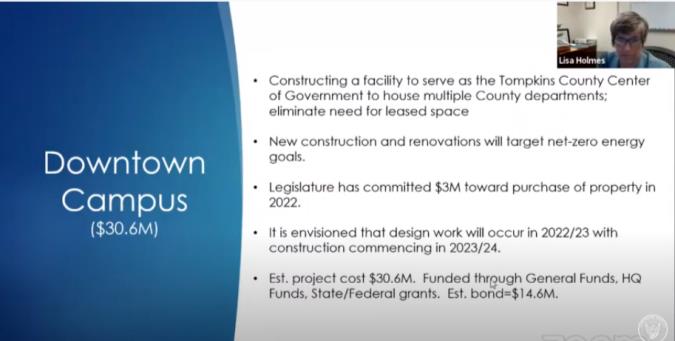
by Robert Lynch, September 14, 2021
When Interim County Administrator Lisa Holmes tossed out the number, legislators never batted an eye. They never asked a question. They took it in stride. It may be because they’ve been working on the inside. The rest of us have not.
Outlining County Administration’s proposed Tompkins County Budget for next year, Holmes unveiled a Capital Plan Tuesday night (Sept. 14th) that pegged the cost of a New Downtown Office Building—the Center of Government seen as a crown jewel by some on the County Legislature—at over $30 Million, up more than 50 per cent from when a former Administrator first presented cost figures to lawmakers two years ago.
“The current estimate for the new construction project totals $30.6 million” Holmes wrote in her 2022 Capital Plan and Budget narrative. “The Center of Government project is budgeted to be funded through a combination of bond proceeds, general funds, and State/Federal grants.”
“Right now, it’s envisioned the design work will occur in 2022 and 2023 with construction possibly commencing in 2023 and 2024,” Holmes told legislators in her verbal presentation Tuesday.
When former County Administrator Jason Molino first outlined the Downtown Office project to the County Legislature in a flashy, PowerPoint-assisted presentation in April 2019, he’d put the price of construction and associated renovations at between $18.55 Million and $19.55 Million. Since then, however, the cost estimate, kept largely in the shadows, has edged up year-by-year, ballooning by $2.5 Million for the year ahead.
The latest increase appears fueled largely by the County’s decision last month to buy a new site for the project, acquiring two buildings adjacent to the Courthouse for a combined $2.8 Million. To provide itself a cushion, a key County committee last week recommended transfer of an even $3 Million from fund balances to cover the acquisition.
“We don’t have to have a new County Office Building tomorrow,” Dryden legislator Mike Lane cautioned the Legislature’s Downtown Facilities Committee September 9th. But the prevailing attitude at every legislative discussion of the project over the past two years has carried a sense of fait accompli; that the building will get built; it’s just a matter of when.
The night the County Legislature in 2019 bought its first site for the Center of Government—land a block away, now likely abandoned to other uses—a critic (this writer) described it as “office creep,” intrusion of a lubberly misfit into a residential neighborhood. But the more proper term today may be “cost creep.” Careful examination of the County’s annual budgets shows rapid escalation in the Center of Government’s cost, its construction sidelined for two years while county officials secretly negotiated to buy the new land.

Whereas Molino’s 2019 estimate of around $19 Million may have held that April, the Administrator’s projected 2020 budget, drafted just months later, jacked up the cost to $22 Million. A year after that—amidst the shutdowns of COVID, when few paid attention—the project’s price tag jumped again to $28.1 Million. Now it tops $30M.
Holmes’ capital breakdown, presented County legislators Tuesday as they met as a committee of the whole, called for drawing $2 Million for the building project from next year’s fund balances. $1 Million would be similarly spent the following year, with $3.2 Million spent 2024 and again in 2025. As much as $14.6 Million would be bonded. A rather small slice, just $2 Million, would come from projected State aid.
****
As to next year’s overall proposed 2022 Budget, presented by Holmes, Tompkins County would spend nearly $194 Million, up nearly 2.7 per cent from the current year’s spending plan. The proposed tax levy of $53.8 Million would rise by 2.7 per cent from this year’s. The current budget, adopted last fall, kept the levy increase at about a half percentage point lower. But the next year’s increase, reported the Interim Administrator, falls well beneath New York’s largely-symbolic property tax cap.
And if Administration figures hold true, Tompkins County, as usual, would end the New Year with plenty of money in the bank. The budget projects a $42.6 Million Unassigned General Fund Balance for 2022, down about $5 Million, the decrease resulting from Legislature plans to tap the fund balance for various capital projects, including the new building.
###
Town Board rejects Enfield Vaxx Mandate 3-1; Resubmission planned
“I thought I was going to die! I literally thought I was going to die for the first—for a 24-hour session after my second shot. I thought I should maybe take myself to the hospital as fast as I could. If I could have moved six inches I would have gotten my phone to call an ambulance. I will not be getting a booster shot! I will not, because I got that sick.”
Enfield Supervisor Stephanie Redmond, on her experience with the COVID vaccine.
“[A]s soon as I’m eligible for a booster shot, which is on the 9th of December, I’m going to get one…. And I know it may floor me for a day. That’s better than being on a ventilator, and I don’t want to be there.”
Enfield Councilperson Robert Lynch on his plans to get a booster shot.
Posted by Robert Lynch; original story on September 8, 2021; updated September 12, 2021
Following President Biden’s call September 9th for larger employers to mandate workers vaccinate against COVID-19 or else be tested weekly, an Enfield Councilperson (this writer) pledged Friday to reintroduce a Resolution that would require the same tough standards apply to his Town’s workforce, despite the Town Board’s lopsided rejection of that initiative just one night before the President’s edict.
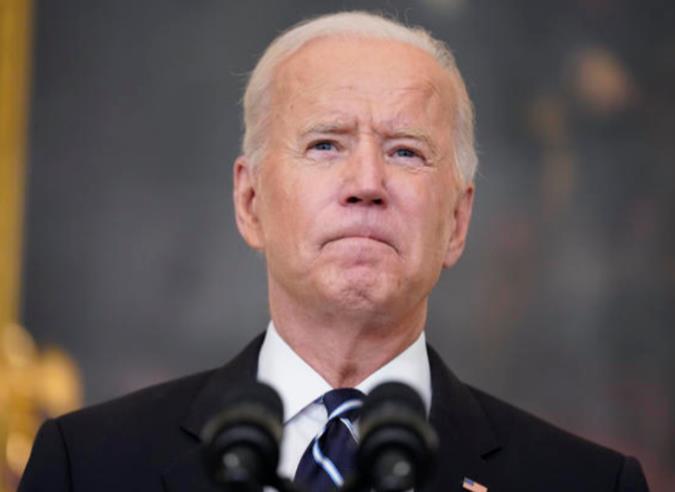
Councilperson Robert Lynch’s “Resolution to establish a Vaccination Policy against COVID-19 for Public Officers and employees of the Town of Enfield,” lost Wednesday by a vote of 3-1. Only Lynch voted for it. Supervisor Stephanie Redmond called the resolution “pointless.”
“Be advised that in view of national and New York State announcements either made or coming to light since our September 8th meeting, I intend to reintroduce my [Resolution] at our Board’s October 13th Regular Meeting,” Lynch wrote the Board in an email September 10th. Lynch raised the prospect of moving his motion at an earlier special meeting, should one be called.
Lynch noted that the Presidential directive of Thursday would not extend to smaller employers like Enfield, a municipality with fewer than 100 workers. “I believe we owe it as responsible public servants to abide by [the President’s] directives, nonetheless,” Lynch wrote, adding, “I believe my earlier Resolution, subject to subsequent amendment by this Board, helps fulfill the spirit of what all American employers have been asked to do.”
The Enfield vaccination mandate stands similar to, and is modeled after, one that the Tompkins County Legislature adopted for its own workforce August 10th amid little controversy. It would require employees to vaccinate by set deadlines or else fall subject to frequent COVID testing. Tompkins County’s requirements will take effect October 1st. As written, the Enfield mandate would kick in 60 days after its passage.
The September 8th Town Board defeat of the Enfield mandate marked yet another instance of Councilperson Lynch finding himself alone as the Board’s one-man minority. Supervisor Stephanie Redmond and Councilpersons Virginia Bryant and Jude Lemke voted against the initiative. (Councilperson James Ricks was excused.) Lynch said later he’d expected defeat when the vote was called.
Redmond termed the mandate “pointless,” she said, “because I think we’re all just as likely, pretty much, to be harboring this virus and spreading it as an unvaccinated person.” She quickly qualified her appraisal.
“Slightly, potentially,” the Supervisor acknowledged, “you have more of a chance of spreading it (COVID) if you’re unvaccinated. But let’s not pretend that just because we’re vaccinated we can’t spread it.”
Lynch countered the Supervisor’s assertion by placing within his amended Resolution direct quotes from Tompkins County’s Public Health Director and its Medical Director, both of whom, if present, would likely have contested Redmond’s broad-brush assertion.
“The data still show that if you are vaccinated you are at a lower risk of getting or transmitting COVID-19,” Public Health Director Frank Kruppa said in a September 1st public guidance document, even though Kruppa acknowledged having seen “an uptick in cases and the number of vaccinated people becoming positive.”
Medical Director Dr. William Klepack told the Tompkins County Legislature on the day it adopted its own mandate that one’s “extremely unlikely to get infected,” if vaccinated; less likely still to become seriously ill with COVID or die.
But perhaps straining at hyperbole, Redmond said Wednesday she felt like she was dying from the immune response she had to her vaccination of last spring. As a result, the Supervisor took aim at a clause in Lynch’s submission that would have mandated employees receive COVID booster shots within six months of their eligibility or else fall out of compliance.
“Robert, you say it was like just a little bit of an illness for you when you got your shot,” Redmond said to Lynch. “I thought I was going to die! I literally thought I was going to die for the first—for a 24-hour session after my second shot. I thought I should maybe take myself to the hospital as fast as I could. If I could have moved six inches I would have gotten my phone to call an ambulance. I will not be getting a booster shot! I will not, because I got that sick.”
Redmond said she’d heard that “people who are younger and have a healthier immune system” often develop strong responses. She predicted fears like hers will dissuade other workers from getting their own boosters.
“And that’s unfortunate,” Lynch responded. “Because, I mean, as soon as I’m eligible for a booster shot, which is on the 9th of December, I’m going to get one…. And I know it may floor me for a day. That’s better than being on a ventilator, and I don’t want to be there.”

The Supervisor’s other colleagues were driven to her side Wednesday for different reasons. Lemke reasoned that a tough, enforceable masking mandate—debated, but then tabled that night—would suffice; limiting the contagion’s spread without imposing the Town’s heavy hand.
Of the vaccine requirement, Lemke warned, “I suspect that this will create a lot more upset with the employees than the mask mandate. I think a reasonable mask mandate is probably preferable in my view.”
Councilperson Bryant, meanwhile, worried the testing regimen—likely weekly—for those who refuse vaccination would burden the workforce too much.
“It’s another, yet another policy that puts more responsibility on people” Bryant said. “They have enough to deal with anyway. You can’t protect everybody from everything.”
Indeed, the burden-factor stood among the reasons for Redmond’s own opposition. The Supervisor reported that an unidentified employee with a “medical situation” has not and will not get the vaccine. Even when Lemke suggested the Town compensate that employee for her testing time, Redmond balked.
“I feel like it would be inappropriate for us to do that and burden them further, especially when I feel like I am just as likely being vaccinated to infect someone with COVID as this person is,” the Supervisor insisted.
A chorus of libertarian and anti-vaxx voices within Enfield—though perhaps reflecting a minority opinion—has brought to the Enfield debate a level of division not sensed within Tompkins County as a whole.
While some in Enfield may clamor for individual choice and call for governmental restraint, Lynch pushed back Wednesday with his appeal to a collective sense of community and to public safety.
“You are your brother’s keeper,” Lynch reminded the Board. And with a vaccination mandate, he said, “you are trying to protect your fellow citizens. I believe in that. And I believe that we have to think about more than our own selfish interests.”
“And we as a Town Board,” Lynch acknowledged, “Yes, maybe we’re like a Town Nanny. Maybe, to a certain extent, we’re being a nanny here…. A person at the last meeting said very sincerely, ‘You can’t—People have to protect themselves; you can’t protect them.’ Well, yes, maybe we can help protect them. And maybe we should. Maybe we should look out for our employees because they’re good people. And maybe we should give a little nudge. And this might do it.”
****
Before the Enfield Board debated—and dispatched (at least for that evening) the vaccine mandate, it discussed, only to then table, a parallel COVID-fighting measure, in this case, the imposition of a tough masking mandate for all Town employees and visitors.
The mask mandate, proposed by Redmond, but later given a drastic overhaul by Lynch, would, if adopted, require all employees and visitors to Town facilities mask-up or suffer consequences.
Most controversially, Redmond’s original masking measure would have subjected non-compliant employees to potential “dismissal.” Lynch’s overhaul would have stripped away the prospect of termination, and substituted more benign language lifted from Tompkins County’s personnel policies.
But Lemke and Redmond worried the amendment’s bow to voluntary compliance lacked sufficient toughness. They urged deletion of Lynch’s stipulation that Town officials “will not routinely check whether individuals are not wearing masks in their workplace settings absent complaints,” tactics that Lynch worried might reopen old wounds between the Town and its workforce. Lynch refused to revise the stipulation, and the Board quickly tabled the mask mandate until October.
In other action Wednesday:
- The Town Board voted unanimously to return temporarily to online meetings in view of recently-adopted State legislation—encouraged, and perhaps originated, in Enfield—a waiver of law that enables municipal bodies to meet remotely at least through mid-January.
- The Board also adopted a Resolution, authored by Lynch, that directs a citizen committee to draft a Local Law that would again impose a short-term moratorium on applications for new solar farms. Though the already-approved, yet unbuilt, Norbut Solar project off Applegate Road would not be affected, the Board agreed the Solar Law’s financial requirements, and perhaps other provisions, need toughening. Most particularly, they’d like to mandate solar developers provide “Host Community Agreements” that directly—and exclusively—benefit the Town. Norbut officials refused to provide Enfield such an agreement after they’d negotiated a tax abatement plan with a County agency.
###
Newfield Board greases the skids for more broadband
by Robert Lynch, September 10, 2021
It’s called the “Millard Hill Corridor.” And by and large, it remains in the Dark Ages of the information-driven 21st Century.
Nonetheless, for those residents of Newfield roads like Millard Hill, Fishkill, and Burge Hill, the dawn of enlightenment may soon be coming.
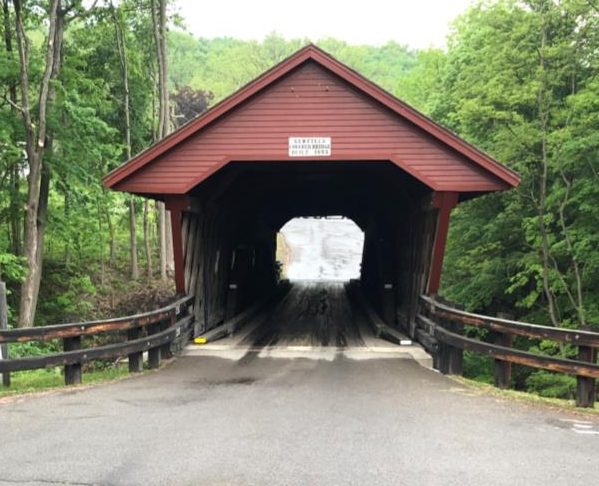
Doing its part, pledging its minimal share, the Newfield Town Board Thursday (Sept. 9th) committed $5,000 in Town funds toward a much-larger subsidy by Tompkins County Government to underwrite a private firm’s stringing fiber-optic cable to some 180 households in Newfield’s northern rural reaches, on roads near the Enfield town line. The area presently lacks hard-wired broadband. From this writer’s journey on his legislative campaign trail this past spring, broadband deprivation arose as residents’ most frequent complaint.
“You have to take this on one piece at a time,” Supervisor Michael Allinger cautioned his Town Board Thursday prior to its unanimous funding vote. The Supervisor admits other Newfield neighborhoods still need broadband cable. But this, Allinger said, is a start.
Under the currently-negotiated plan, Point Broadband (formerly Clarity Connect) would invest $280,000 to string its cables throughout the Millard Hill Corridor. To make it pay, the service provider asked Tompkins County for $75,000 in assistance. A County committee, in turn, asked the Town to chip in Five Grand. Given Thursday’s Town Board approval, the County Legislature stands poised to ratify the arrangement at a Special Meeting Tuesday, September 14th.
Last-minute changes remain possible. Allinger says County officials await a potential competing offer from Charter-Spectrum, Newfield’s principal cable provider. It’s possible Spectrum could offer the County a sweeter deal, which they might then accept. Allinger told the Board that Haefele Connect, Enfield’s major provider, was also approached, but showed no interest.
Board members Thursday looked beyond the Millard Hill Corridor achievement to other broadband challenges in similarly poorly-served parts of the Town.
“We need to do more,” stressed Councilperson Joanne James. “Do we need an ad-hoc committee?”
“Maybe we should use ARPA (American Rescue Plan) funds to do different projects?” suggested Town Bookkeeper Blixy Taetzsch.
“For the south side of the Town (still underserved), it might be wise to look at Haefele again,” said Councilperson Christine Laughlin.
In recent months, and again Thursday, Board members lamented the presumed failure of last year’s ambitious County-sponsored initiative that sought to create a governmentally-run rural broadband network. Though launched with great fanfare this spring, the project has disappointed County planners to the point that they placed a “pause” on a consultants’ study in early-August. Thursday afternoon, a planning official informed all municipalities—including Newfield and Enfield—that the County will not seek to collect municipal contributions (also of $5,000) that the towns and villages had pledged toward the earlier initiative.
On a second matter Thursday, the Newfield Board began discussions, but made no decisions, on whether to opt-in or opt-out of the State’s new marijuana dispensing laws.
Each town has until year’s end to make a potentially one-way decision on whether to permit or prohibit cannabis dispensaries within its borders. If a town opts-out and bans dispensary sales, it can later opt back in; but if it initially permits distribution, it cannot later prohibit it.
Councilperson Heather McCarty said that as a parent, she might support local dispensaries as a safer alternative to casual street sales. She observed that a “regulated dealer” remains subject to state control, whereas unregulated sources might entice customers to buy stronger drugs. “It might make the use safer in some places,” McCarty said.
On the other hand, Allinger noted, an opt-out position would enable the Town to take “a wait and see approach” as to benefits versus drawbacks of marijuana sales.
The State’s marijuana laws provide opportunities for public referenda by petition. Laughlin suggested it might be best for the Town to call the referendum itself and let the people decide.
###
McKenna suggests razing Old Jail to site new County offices
By Robert Lynch; September 9, 2021
He may have raised it only as a trial balloon. But for some, it may have fallen like a lead one.
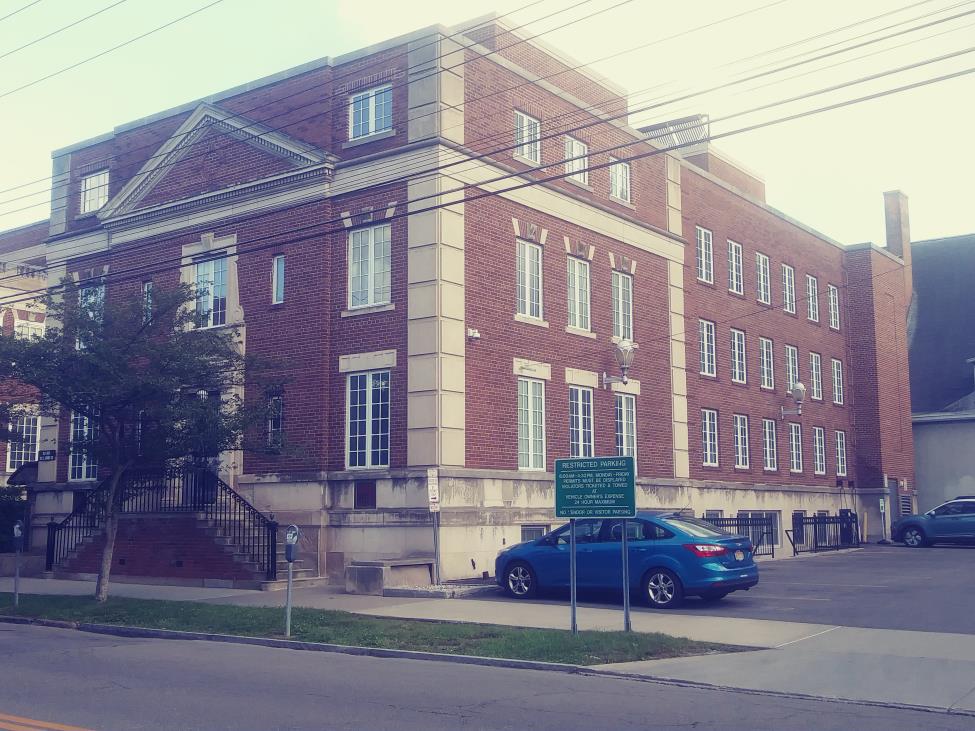
Becoming the latest twist in Tompkins County’s long-secret, but always-surprising quest for new Downtown real estate, the Chair of the search’s oversight committee said Thursday (Sept. 9th) he’d favor tearing down the historic Old Jail, adjacent to the Courthouse, so as to enlarge the footprint for a bigger, more inclusive new Center of Government.
“I don’t know if we can do this or not because I don’t know if it’s in a Historic District or not,” Dave McKenna cautioned, “But I’m kinda’ in favor of taking down both Building C and taking down the Old Jail.”
It’s not an efficient building,” the Newfield Republican said of the 1930’s-era repurposed County lockup, “and going forward, I think we’d be far better off by putting everybody under one roof.”
Thursday’s first talk of razing the Old Jail came just weeks after the County Legislature’s purchase August 17th of two buildings adjacent to the current Courthouse. The Legislature agreed to buy the Key Bank building at the corner of Tioga and Buffalo Streets and the adjacent Wiggins Office Building for a combined $2.8 Million. Lawmakers intend to demolish both structures, along with the County-owned “Building C,” currently housing the Board of Elections and the Assessment Department. The County would likely then replace them with a new office building perhaps six stories high and costing upwards of $20 Million.
Until last month, County legislators and administrators had kept purchase negotiations a closely-guarded secret for nearly two years. McKenna has justified confidentiality on grounds the County needed to keep potential competing bidders in the dark.
But no one in County government, including on the Legislature, had ever suggested also taking down the Old Jail—until now.
“Dave, you said something that really knocked me back on my heels,” a startled Deborah Dawson, a member of McKenna’s Downtown Facilities Committee, responded with surprise. “You said you’d tear down the Old Jail. I thought that building was historic, protected.”
Indeed, it may be. And the historic designation could thwart McKenna’s call for the wrecking ball. The three-story brick edifice—sandwiched between the current Courthouse and the 1850’s-era former Courthouse, the Gov. Daniel Tompkins Building, the Legislature’s current home—likely holds landmark status. Legislator Leslie Schill informed her colleagues the Old Jail rests within the DeWitt Park Historic District and holds designation on the National Register of Historic Places.
“These statuses would have to go through State Historic Preservation Office review if you were looking to demolish,” cautioned Schill. “They’re in there. They’re listed.”
Committee members begged the County Attorney or the Assessment Director to provide legal guidance. Neither responded. Interim County Administrator Lisa Holmes said she knew too little about the matter to offer an opinion.
While landmark status often stands as a firm roadblock to private redevelopment, governments, by their mere nature, sometimes command clout.

Regardless of the obstacles, McKenna made no secret that the Old Jail, to him, would be better gone than standing.
“I’d like to open that whole area up,” McKenna said, eager to provide a new office building as much breathing room as possible. And of the jail, he said, “The building is terribly inefficient, anyway.”
The Newfield lawmaker was not alone in his opinion.
“You’re absolutely right,” Dawson said in response to McKenna’s assessment. Of the Old Jail, she remarked, “It’s going to cost us a fortune to try to make it efficient.”
Nonetheless, both legislators can be faulted for failing to look out their windows. Behind the Old Jail stands the equally (or even-more) historic First Baptist Church. It blocks the jail from the rest of the development site. And no one’s talking about tearing down the church.
The County repurposed the Old Jail in the early 1990’s as it transferred prisoners and the Sheriff’s Department to a newer facility on Warren Road. Historic Ithaca responded by awarding Tompkins County a preservation award.
Yet underlying the Old Jail discussion stands a larger, more costly question. It’s whether McKenna and his colleagues now plan a grander, more expensive County office complex than they’d originally envisioned, since they’ve laid claim to the land that’s truly their favorite.
“All the departments that can be in there should be there,” McKenna said of the envisioned Center of Government, its increasingly-popular name. “We obviously can’t move the Airport or the Health Department in there, or Public Works, but everybody else can be there pretty much.”
****
Ironically, the discussion that spawned McKenna’s newsworthy tidbit Thursday wasn’t even on the Downtown Facilities Committee’s agenda. The item that was there, members quickly approved, and with hardly any discussion. They recommended the Legislature tap $3 Million from its Unassigned Fund Balance to purchase the Key Bank and Wiggins properties. Even after the transfer, the Fund Balance still has tens of millions left.
“I oppose this,” Enfield Councilperson Robert Lynch (this writer) said of the purchase transfer, his remarks coming prior to McKenna’s bombshell comment concerning the Old Jail. “I think it is unwise spending,” Lynch asserted. “I don’t think we need the land, and I don’t think we need the building.”
And referencing the fact that the County Legislature had two years ago bought another multi-Million Dollar parcel one block away as its originally-intended office site, Lynch accused legislators of harboring “buyer’s remorse.”
“Most of us are not entitled to make these after-the-fact decisions,” Lynch said. “But County Government that has an unlimited supply of money is allowed to do that. I don’t think that we should.”
###
Tompkins legislators revise ethics rules; skirt “anti-politicking” provision
by Robert Lynch, September 7, 2021

Avoiding what some might see as the political “elephant in the room,” the Tompkins County Legislature Tuesday (Sept. 7th), without dissent, adopted revisions to the County’s Code of Ethics, an 11-page document that lays down legislator and employee do’s and don’ts regarding, among other things, conflicts of interest, financial solicitations, and the handling of confidential information.
But the ethics code has not—and still does not—specifically prohibit County lawmakers or employees from using public meetings or public resources to lobby for or against political candidates.
“It’s not really necessarily something that would go into the Code of Ethics,” argued Government Operations Committee Chair Amanda Champion, who responded Tuesday when quizzed by fellow legislator Anne Koreman as to whether the committee considered limiting political advocacy as it revised the ethics document. Instead, Champion told Koreman, her committee “did include a sentence or two” in a pair of obscure Legislative Rules its members are concurrently updating. The latter revisions may be finalized at the committee’s October meeting.
What prompted Koreman’s query was the comment a lone speaker made at the start of Tuesday’s meeting. Enfield Councilperson Robert Lynch (this writer), at a Public Hearing, urged the Legislature insert a new paragraph into the Code of Ethics, one that would bar political interest conflicts.
“No County officer or employee,” proposed Lynch in his requested amendment, “shall misuse his or her position, while performing official duties, to advocate for or against the election of a candidate competing in any local, state, national, or other governmental election in which Tompkins County residents might participate.”
The proposed amendment would also prohibit County officers or employees, while performing official duties, from “advocate[ing] for or against a ballot referendum affecting any other governmental jurisdiction, apart from his or her participating, for or against, an official action on such referendum to be taken collectively by County Government as a whole.”
“A legislative forum should never be used as an electioneering soapbox,” Lynch told County Legislators at the Hearing. He said his amendment would not restrict legislators or employees from advancing or opposing political candidates on their private time. Nor would it restrict lawmakers should they move as a group to support or oppose ballot referenda. “It would only limit the abuse of official privilege,” he said.
The most recent instance of a Legislator potentially stepping over the County’s unwritten line came May 18th when Dryden Legislator Martha Robertson used her legislative privilege-of-the-floor to urge voters troop to the polls in the final hours of the Dryden School Board election to support Robertson’s two preferred candidates. The two later won by a handful of votes.
It was Koreman who that evening faulted Robertson for her impromptu electioneering. “I just feel uncomfortable with, at a County Legislature meeting,” Koreman admonished her fellow lawmaker, “talking about… who we want to be on the School Board.”
The following month, Government Operations Committee Chair
Champion, without referencing the Dryden incident, suggested it might be time
to consider a Legislator Code of Conduct.
While the Code of Ethics—a separate document—breezed through Champion’s
committee in August without serious debate, the committee chair acknowledged
that later an informal subcommittee of hers had toyed with—but then rejected—creating
the Code of Conduct.
“We ended up coming to the conclusion,” Champion told the
Legislature Tuesday, “that we should really not make a whole new document,” but
rather, she said, “bring these ideas into the current Rules of the Legislature
that we have”
Councilperson Lynch advised Champion after Tuesday’s meeting that he would have preferred the politicking prohibition had been placed within the Code of Ethics, so as to give it added “stature.” The Enfield lawmaker, himself, a candidate for the County Legislature, indicated he would continue to press for the amendment’s inclusion
###

